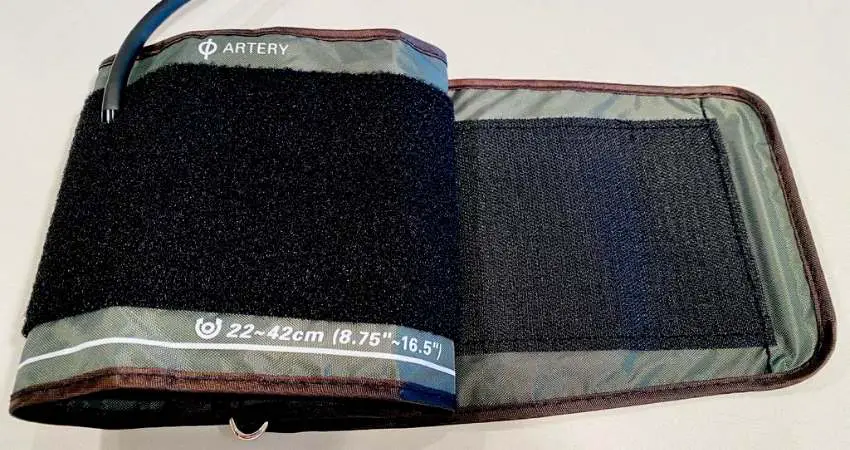Measuring blood pressure can be tricky. It’s not as easy as wrapping the cuff around your arm and pressing the start button. Many factors must be considered and followed prior to taking a blood pressure reading. One of them is the size of the bladder which may make you wonder, what is the correct blood pressure cuff bladder width?
A blood pressure cuff bladder should measure between 37%-50% of the circumference of the upper arm as per the American Heart Association. Using a bladder width within the correct range is crucial for accurate blood pressure measurements. A bladder width too long or short can cause a lower or higher blood pressure reading.
Achieving the correct cuff bladder width for you involves a few steps which I’ll explain to you in this blog post. In addition, I’ll inform you what the difference is between a bladder and cuff. If you measure the wrong part, you’ll end up using the incorrect cuff for your arm resulting in inaccurate measurements1.
BP Tip: Always check the size range of a blood pressure cuff and compare it to your arm size prior to ordering. In addition, purchase a monitor which allows the cuff to be changed.
The monitor I use and recommend allows cuffs to be changed. This is extremely important for two people who may have different arm sizes. Check the current price on Amazon for the one I use, Welch Allyn 1700 Series or read about it in complete detail in my review post.
Disclaimer: Some of links in this article are affiliate links which means I may earn a small commission at no extra cost to you. As an Amazon associate I earn from qualifying purchases.
Blood Pressure Cuff Bladder Width
The measurement of the cuff bladder should be no less than 37% and no more than 50% of your upper arm circumference2. Let’s say your upper arm measures 14″. The bladder width should measure from 5.18″ to 7″ (37%-50% of your upper arm circumference).
The following table indicates the typical cuff sizes, related arm circumferences and cuff bladder dimensions.
| Cuff Size | Arm Circumference – In. Arm Circumference – Cm. |
Bladder Size (W x L) – In. Bladder Size (W x L) – Cm. |
| Small Adult | 8.66″ – 10.23″ 22 -26 cm. |
4.72″ x 8.66″ 12 x 22 cm. |
| Adult | 10.62″ – 13.38″ 27 – 34 cm. |
6.29″ x 11.81″ 16 x 30 cm. |
| Large Adult | 13.77″ – 17.32″ 35 – 44 cm. |
6.29″ x 14.17″ 16 x 36 cm. |
| Extra-Large Adult |
17.71″ – 20.47″ 45 – 52 cm. |
6.29″ x 16.53″ 16 x 42 cm. |
The Difference Between Cuff Bladder Width and Cuff Width
The cuff bladder is the part of the cuff that inflates. It’s not visible by the eye and is sewn inside of the outer cuff material that you do see. Typically, when people refer to the blood pressure cuff, it’s the material you see that contains the printed instructions and velcro. The cuff also contains the bladder3.
The bladder is always smaller than the actual cuff size, both width and length. The arm range size listed on the cuff is not the same size of the cuff material.
While the bladder width should be between 37%-50% of the upper arm circumference, the advertised cuff sizes are a different measurement. The manufacturers don’t list or advertise the bladder size, typically they list just the arm size range the cuff is made for.
For example, the blood pressure cuff with my home monitor fits an arm range of 8.75″-16.5″. If your upper arm circumference falls in between those two numbers, typically the cuff and inside bladder should be appropriate for your arm.
So when ordering your home monitor, check their recommended arm circumference for the cuff included with their monitor. If you’re not sure how to obtain your upper arm circumference, you’re in luck because that’s the next topic of this post.
BP cuff width is one of 14 sections in my article about blood pressure cuffs. Learn more about BP cuffs, including how to apply them, errors made and sizes, here in the article, Blood Pressure Cuffs.

How to Measure Your Upper Arm Circumference
What is the upper arm circumference? It’s the diameter of your upper arm (the measurement around the arm). The following are the steps4 you must follow to achieve the appropriate measurement:
- Use a cloth measuring tape.
- Keep the arm you’re measuring straight down and relaxed.
- Do not flex the arm or make a muscle.
- Wrap the cloth measuring tape completely around the arm. Ensure it’s evenly wrapped and level.
- Keep the tape firm but not squeezing the skin.
- Position the tape midway between your shoulder and elbow.
- Note the measurement and keep it with your BP records.
If you’re purchasing a new home monitor, check your arm measurement against the arm size range listed with the monitor. Remember, the size range is not the cuff bladder width or length. If it doesn’t match and that’s the monitor you desire, ensure the cuff can be changed and order the monitor plus the additional cuff correct for your arm. Don’t worry, the cuffs are extremely easy to change.
I disconnect my cuff after every use before storing back in its box. If you need to order another size cuff, they have plenty of them listed on Amazon which you can check by clicking right here, BP cuffs.
Another reason why you may need to order a second cuff is because you and your spouse may have different size arms, but want to use the same monitor. It’s crucial you get the sizes correct, if not the next topic explains what may happen.

What Happens if the BP Cuff Bladder Width is Incorrect?
If the bladder width is longer than what you require, it will encase a larger percentage of your upper arm than what it’s supposed to. This may close off your blood vessels faster than it should and result in a lower blood pressure reading ((National Center for Biotechnology Information: Blood pressure measurement)).
If the bladder width is shorter than what you require, it will wrap less around your upper arm than what it’s supposed to5. This will force your cuff to inflate more than typical to close off the blood supply in your upper arm vessels. When this happens, your measurement will result in a higher blood pressure reading ((National Center for Biotechnology Information: Blood pressure measurement)).
In a study that included 137 patients, three different size blood pressure cuff bladders were used. One was the correct size, one bladder width and length was too small and the third too large. When the smaller width bladder was used, systolic BP measured 5 mmHg higher. When a larger bladder width was used, systolic measured 5 mmHg lower ((Hypertension: Abstract P182: Quantifying Differences in Blood Pressure by Using Different Blood Pressure Cuff Sizes in Children)).
In another study researching the effect of cuff positioning, smaller bladder widths were used during their research. Both systolic and diastolic pressure were increased when the smaller size was used ((Journal of Hypertension: Impact of cuff positioning on blood pressure measurement accuracy: may a specially designed cuff make a difference?)).
Read Next – More BP Cuff Articles!
Can A Blood Pressure Cuff Be Too Tight?
Blood Pressure Cuff Bladder Length
- National Center for Biotechnology Information: Review: a century of confusion; which bladder for accurate blood pressure measurement? [↩]
- Hypertension: Measurement of Blood Pressure in Humans: A Scientific Statement From the American Heart Association [↩]
- National Center for Biotechnology Information: Blood pressure measurement [↩]
- John Hopkins Children Center: Blood Pressure Measurement Essentials [↩]
- Oxford Academic: P-175: Accurate cuff size in blood pressure measurement [↩]